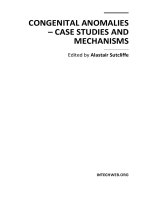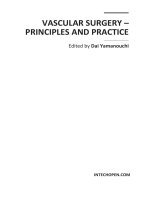Hematology – Science and Practice Edited by Charles H. Lawrie pot
Bạn đang xem bản rút gọn của tài liệu. Xem và tải ngay bản đầy đủ của tài liệu tại đây (20.22 MB, 612 trang )
HEMATOLOGY – SCIENCE
AND PRACTICE
Edited by Charles H. Lawrie
Hematology – Science and Practice
Edited by Charles H. Lawrie
Published by InTech
Janeza Trdine 9, 51000 Rijeka, Croatia
Copyright © 2012 InTech
All chapters are Open Access distributed under the Creative Commons Attribution 3.0
license, which allows users to download, copy and build upon published articles even for
commercial purposes, as long as the author and publisher are properly credited, which
ensures maximum dissemination and a wider impact of our publications. After this work
has been published by InTech, authors have the right to republish it, in whole or part, in
any publication of which they are the author, and to make other personal use of the
work. Any republication, referencing or personal use of the work must explicitly identify
the original source.
As for readers, this license allows users to download, copy and build upon published
chapters even for commercial purposes, as long as the author and publisher are properly
credited, which ensures maximum dissemination and a wider impact of our publications.
Notice
Statements and opinions expressed in the chapters are these of the individual contributors
and not necessarily those of the editors or publisher. No responsibility is accepted for the
accuracy of information contained in the published chapters. The publisher assumes no
responsibility for any damage or injury to persons or property arising out of the use of any
materials, instructions, methods or ideas contained in the book.
Publishing Process Manager Sandra Bakic
Technical Editor Teodora Smiljanic
Cover Designer InTech Design Team
First published February, 2012
Printed in Croatia
A free online edition of this book is available at www.intechopen.com
Additional hard copies can be obtained from
Hematology – Science and Practice, Edited by Charles H. Lawrie
p. cm.
ISBN 978-953-51-0174-1
Contents
Preface IX
Part 1 Blood Physiology 1
Chapter 1 Mechanisms Controlling Hematopoiesis 3
Katja Fiedler and Cornelia Brunner
Chapter 2 Negative Regulation of Haematopoiesis:
Role of Inhibitory Adaptors 47
Laura Velazquez
Chapter 3 The Role of EMT Modulators
in Hematopoiesis and Leukemic Transformation 101
Goossens Steven and Haigh J. Jody
Chapter 4 Asymmetric Division in
the Immuno-Hematopoietic System 121
Daniel Jimenez-Teja, Nadia Martin-Blanco and Matilde Canelles
Chapter 5 Nitric Oxide / Cyclic Nucleotide Regulation
of Globin Genes in Erythropoiesis 135
Vladan P. Čokić, Bojana B. Beleslin-Čokić, Gordana Jovčić,
Raj K. Puri and Alan N. Schechter
Chapter 6 Mechanisms of αIIbβ3 Biogenesis in the Megakaryocyte:
A Proteomics Approach 171
Amanda Chen, Haiqiang Yu, Haiteng Deng and W. Beau Mitchell
Chapter 7 SATB1: Key Regulator of T Cell
Development and Differentiation 195
Kamalvishnu P. Gottimukkala, Mithila Burute and Sanjeev Galande
Chapter 8 Neutrophil Chemotaxis and Polarization:
When Asymmetry Means Movement 211
Doris Cerecedo
VI Contents
Chapter 9 Intravascular Leukocyte Chemotaxis:
The Rules of Attraction 229
Sara Massena and Mia Phillipson
Chapter 10 Membrane Trafficking and Endothelial-Cell
Dynamics During Angiogenesis 253
Ajit Tiwari, Jae-Joon Jung,
Shivangi M. Inamdar and Amit Choudhury
Part 2 Hematological Pathologies 281
Chapter 11 Translational Control in Myeloid Disease 283
Nirmalee Abayasekara and Arati Khanna-Gupta
Chapter 12 Molecular Mechanisms in Philadelphia
Negative Myeloproliferative Neoplasia 299
Ciro Roberto Rinaldi, Ana Crisan and Paola Rinaldi
Chapter 13 Physiological and Pathological
Aspects of Human NK Cells 337
Chiara Vitale, Renato Zambello, Mirna Balsamo,
Maria Cristina Mingari and Massimo Vitale
Chapter 14 Stratification of Patients with Follicular Lymphoma 371
Hasan A. Abd El-Ghaffar, Sameh Shamaa, Nadia Attwan,
Tarek E. Selim, Nashwa K. Abosamra, Dalia Salem,
Sherin M. Abd El-Aziz
and Layla M. Tharwat
Chapter 15 MicroRNA Expression in Follicular Lymphoma 393
Charles H. Lawrie
Chapter 16 Epstein-Barr Virus-Encoded miRNAs
in Epstein-Barr Virus-Related Malignancy 409
Jun Lu, Bidisha Chanda and Ai Kotani
Chapter 17 Animal Models of Lymphoproliferative Disorders
Focusing on Waldenström’s Macroglobulinemia 425
Anastasia S. Tsingotjidou
Chapter 18 Systemic Mastocytosis: An Intriguing Disorder 467
Antonia Rotolo, Ubaldo Familiari, Paolo Nicoli,
Daniela Cilloni, Giuseppe Saglio and Angelo Guerrasio
Part 3 Hematology in the Clinic 487
Chapter 19 Targeting the Minimal Residual Disease in Acute Myeloid
Leukemia: The Role of Adoptive Immunotherapy with
Natural Killer Cells and Antigen-Specific Vaccination 489
Sarah Parisi and Antonio Curti
Contents VII
Chapter 20 The Ubiquitin-Proteasomal System and
Blood Cancer Therapy 497
Xinliang Mao and Biyin Cao
Chapter 21 Heparin-Induced Thrombocytopenia 517
Kazuo Nakamura
Chapter 22 Converting Hematology Based Data
into an Inferential Interpretation 541
Larry H. Bernstein, Gil David,
James Rucinski and Ronald R. Coifman
Chapter 23 The Effects of Splenectomy and Autologous
Spleen Transplantation on Complete Blood Count
and Cell Morphology in a Porcine Model 553
Nina Poljičak-Milas, Anja Vujnović, Josipa Migić,
Dražen Vnuk and Matko Kardum
Chapter 24 Physiological Factors in the Interpretation
of Equine Hematological Profile 573
K. Satué, A. Hernández and A. Muñoz
Preface
‘Blood, blood, glorious blood,
Thicker than water and nicer than mud’
Humphrey Kay - The Hematologist’s Song
Hematology encompasses the physiology and pathology of blood and of the blood-
forming organs. In common with other areas of medicine, the pace of change in
hematology has been breathtaking over recent years. There is now a plethora of
treatment options available to the hematologist which happily coincides with a greatly
improved outlook for the vast majority of patients with blood disorders, in particular
those with hematological malignancies. Improvements in the clinic reflect, and in
many respects are driven by, advances in our scientific understanding of
hematological processes under both normal and disease conditions. This book which
consists of a selection of essays aims to inform both specialist and non-specialist
readers about some of the latest advances in hematology, in both laboratory and clinic.
The first section of this book (Section 1 - Blood Physiology) is concerned with the
study of the molecular and cellular mechanisms behind the physiological functioning
of the blood system. The first three chapters deal with the mechanisms behind early
hematopoiesis, the process occurring almost exclusively in the bone marrow by which
all mature blood cells are generated from multi-potent hematopoietic stem cells
(HSCs). This is a finely balanced process that is tightly controlled by a complex
network of inter-related signaling pathways and molecular components. In Chapter 1,
Fiedler and Brunner review some of the intricate regulatory mechanisms involved in
this process, in particular focusing on the role of transcription factors in early lineage
control and lineage commitment. In Chapter 2, Velazquez describes the role that
negative regulation plays in hematopoiesis, and in particular the function of members
of the inhibitory adaptor family such as DOK, Lnk and SOCS, their role in cytokine
signaling pathways and hematological pathologies. This chapter also explores the
potential therapeutic use of these inhibitors and associated regulators. Expanding
upon the theme of hematopoiesis, Goossens and Jody, in Chapter 3, discuss the role of
modulators of the epithelial to mesenchymal transition (EMT) pathway focusing on
the function of SNAI family members, snail and slug, and interestingly how they can
be involved in leukemic transformation.
X Preface
The ability of the HSC (and other cells along the hematopoietic pathway) to divide
into two functionally distinct daughter cells, one that is differentiated whilst the other
retains self-renewal properties and can continue to proliferate, is crucial to the
maintenance of the hematopoietic system. So-called asymmetric division is discussed
in Chapter 4 by Jimenez-Teja et al. The authors outline the historical perspective
behind this field before going into a detailed review of the function of asymmetric
division in both hematopoietic and immune systems, as well as the latest evidence to
suggest that asymmetric division and in particular abnormal functioning of cell fate
determinant molecules can lead to cancer.
After the initial commitment step the HSC loses its ability to self-renew and the
hematopoietic pathway bifurcates with formation of either the common lymphoid
progenitor (CLP) or common myeloid-erythroid progenitor (CMEP) cells. CLPs can
give rise to mature NK, B and T cells, whilst the CMEPs can form erythrocyte,
megakaryocyte, granulocyte and monocyte populations. In Chapter 5, Čokić et al.
describe the role of nitric oxide/cyclic nucleotide regulation in erythropoiesis, the
formation of red blood cells (erythrocytes). In this chapter the authors provide an
overview of the erythropoietic pathway including the crucial role that GATA1/2 plays
in hemoglobin switching. They present some novel findings whereby they used
microarrays to measure changes in expression levels of globin-related genes during
ontogenesis, and later on provide evidence to show that NO and cGMP can induce
globin gene expression.
Platelets play an essential role in hemostasis and thrombosis, initiating clot formation
in response to cellular damage. Central to the clotting process is platelet aggregation
mediated by the cross-linking of intergrin αIIbβ3 to fibrinogen, von Willebrand factor
and other soluble ligands. Aside from their role in physiological processes, platelets
may also form pathological thrombi which can lead to myocardial infarction or stroke.
Therefore inhibitors of αIIbβ3 are of great clinical interest. In Chapter 6, Chen et al. use
a proteomic approach to identify binding partners to αIIb and the αIIbβ3 heterodimer
expressed in cord-blood derived megakaryocytes. Using this technique they identified
and validated DNAJC10 as a novel binding partner of the immature form of αIIbβ3,
and showed that it binds early on in the biogenic pathway. Furthermore, the authors
found that silencing of DNAJC10 could modulate levels of αIIbβ3 in megakaryocytes
as well as HEK293 cells transfected with aIIb and b3 cDNA constructs.
Chapter 7 by Gottimukkala, Burute and Galande concerns the role of the transcription
factor SATB1 in the development and differentiation of T-cells, in particular, the key
role that this molecule plays in T
H differentiation. The authors also describe how the
loss of SATB1 function may be associated with the T-cell lymphoma, Sézary
syndrome.
Cell polarization is necessary for the migration of cells in many processes including
embryogenesis, inflammation and tumor metastasis. Chemoattractant recruitment of
neutrophils to trauma sites is an essential process of the inflammatory response.
Preface XI
Neutrophil polarization involves directional sensing of external stimuli via cell surface
receptors resulting in a reorganization of the cortical cytoskeleton. In Chapter 8,
Cerecedo discusses the molecular mechanisms behind neutrophil migration focusing
on the role of proteins and protein complexes that promote cell polarization. This
theme is expanded in Chapter 9 where Massena and Philipson review leukocyte
recruitment during inflammation, particularly the mechanisms behind the recently
described phenomenon of intravascular leukocyte chemotaxis.
The formation of new blood vessels, or neovascularization, can occur either de novo
(vasculogenesis) or arise from pre-existing vasculature (angiogenesis). Angiogenesis is
a vital process in growth and development as well as in wound healing. It is also
fundamental in the transition of tumors to a malignant state. Angiogenesis involves
multiple cellular processes including cell proliferation, migration, adhesion and
morphogenesis. This process is controlled by a multitude of signaling proteins. Their
membrane trafficking and associated endothelial-cell dynamics are reviewed in
Chapter 10 by Tiwari et al.
In the second section of this book (Section 2 - Hematological Pathologies), the focus
shifts onto discussion of the diseases of the blood system. This section starts with a
chapter by Khanna-Gupta and Abayasekara (Chapter 11) that reviews diseases of the
myeloid system/lineage. This chapter focuses on the role that translational control
plays in myeloid cells under normal and disease conditions. In particular the role
C/EBPα, PU.1, and components of the mTOR pathway are described as well as the role
of post-transcriptional regulation by microRNAs in these processes.
Myeloproliferative neoplasms (MPNs) are a subset of clonal disorders of the myeloid
system that includes diseases of the granulocytes (chronic myeloid leukemia),
erythrocytes (polycythemia vera) and platelets (essential thrombocythemia). Although
essentially chronic in clinical progression, patients have a finite risk of undergoing
evolution to acute leukemic disease. In Chapter 12, Rinaldi et al. review these diseases
and provide a detailed discussion about the role of constitutive activation of tyrosine
kinases, in particularly members of the JAK2 pathway, and how these discoveries are
translating into new therapeutic options.
The next chapters in this section concern malignancies of the lymphoid lineage. In
Chapter 13 Vitale et al. review physiological and pathological features of NK (natural
killer) cells. NK cells are a fascinating lymphoid subset which, relative to the more
commonly studied B and T cells, are very poorly understood. They are a major
component of the innate immune system and play an important role in tumor
immunity and viral defenses. This chapter describes what is known of cellular
interactions between NK cells and other immune components such as dendritic cells,
as well as the molecular pathways involved in these interactions including the pivotal
role of TRAIL. Although rare, NK neoplasms represent a very distinct class of
disorders that can range in their clinical presentation from very indolent to very
aggressive. The latest advances in understanding these diseases are presented in this
chapter along with a discussion of current and future therapeutic options.
XII Preface
Lymphomas are classified as malignancies of NK cells, B lymphocytes or T
lymphocytes. Lymphoma is the fifth most common cancer type in the Western world
and, worryingly, its incidence appears to have steadily increased during recent years.
Chapter 14 concerns the most common form of low-grade lymphoma, follicular
lymphoma (FL). FL accounts for approximately one third of lymphomas in the US and
consequently is a common encounter in the hematology clinic. Despite its high
frequency surprisingly there is no consensus regarding the best treatment protocol for
FL patients, and patients will eventually succumb to the disease with a heterogeneous
range of survival times ranging from less than one year to more than 20 years (median
OS ~10 years). Consequently, a more robust grading and/or stratification scheme
would help refine and define treatment options for FL patients. Chapter 14 reviews the
various techniques currently used in the clinic in respect of FL patients including
clinical, cytogenetic and molecular methods as well as the various algorithms used,
and discusses their relative strengths and weaknesses.
Approximately 30% of FL cases will undergo high-grade transformation to an
aggressive lymphoma that is histologically indistinguishable from diffuse large B-cell
lymphoma (DLBCL). Transformed FL patients have a particularly poor outcome with
a median survival of less than 14 months. The molecular basis of FL transformation is
only poorly understood and importantly to date there are no reliable biomarkers that
can identify FL patients at risk of transformation. Chapter 15 poses the tantalizing
possibility that microRNAs may prove to be suitable biomarkers for these at-risk
patients. The chapter presents the author’s (largely) microarray data suggesting that
biopsies from FL patients that undergo transformation have a microRNA signature
that differs from those that do not undergo transformation. The implication being that
patients can be tested for the presence of this signature and so those that might benefit
from a more aggressive therapy regimen up-front can be identified.
Despite only formally being recognized for just over 10 years, the field of microRNAs
is a useful illustration of the speed of scientific discovery today. In the first two years
after microRNAs were first named (I.e. 2003), there were just over 50 publications; this
number has been growing exponentially since, and there are now more than 15,000
publications (source PubMed; search string= “microRNA”; date=”11/01/12”).
MicroRNAs are now known to play key regulatory roles in virtually every
physiological and pathological aspect of human biology including that of the
hematological system (discussed briefly in Chapter 15). In addition to their utility in
higher organisms, microRNAs also form part of the armory of many pathogens
including viruses. Chapter 16 reviews the function and characterization of microRNAs
encoded by Epstein-Barr virus (EBV), a pathogen intimately involved in
lymphogenesis. As with other herpesvirus family members, the genome of EBV
encodes for multiple microRNAs that are differentially expressed at various stages of
the infectious cycle. EBV-encoded microRNAs have been shown to direct modulate
host cells, for example changing the immune response to favor infection. Indeed, it has
been suggested that these microRNAs play a fundamental role in the maintenance
Preface XIII
(though not necessarily establishment) of EBV-associated cancers such as Burkitt’s
lymphoma and Hodgkin’s disease.
Lymphoproliferative disorders (LPD) is a term used to describe a heterogeneous
group of disorders characterized by the presence of monoclonal or oligoclonal
lymphoid cell expansion. The LPDs includes lymphomas, lymphoid leukemias,
multiple myeloma as well as more rarely encountered entities such as post-transplant
lymphoproliferative disorders (PTLD) and Waldenström’s macroglobulinemia. An
essential tool in understanding the pathogenesis of these diseases is the availability of
a suitable animal model. In Chapter 17 Tsingotjidou tackles this subject with particular
focus on a murine model of Waldenström’s macroglobulinemia developed in the
laboratory of the author.
Systemic mastocytosis (SM) is rare disorder characterized by the presence of excess
mast cells in internal organs in addition to involvement of the skin. SM is a clonal
disorder and can occur in association with hematological malignancies. The most
frequently observed partner malignancies are myeloid in origin. By contrast, there are
very few instances in the literature of SM presenting in concert with lymphoid
malignancies. In Chapter 18, Antonia et al. present a thorough review of what little is
known about SM and its pathology as well as discussing the treatment options
available to the hematologist.
In the third and final section of the book (Section 3 - Hematology in the Clinic), we
turn our attention to the practice of clinical hematology. Essays in this section include
proposals to advance the current treatment regimens of blood disorders as well as
possible novel therapeutics for these diseases. Chapter 19 considers the use of
adoptive immunotherapy in order to target minimal residual disease (MRD) in acute
myeloid leukemia (AML). Although improvements in chemotherapy have greatly
advanced complete remission rates in this malignancy, a significant proportion of
responders retain MRD that is refractory to further treatment interventions, eventually
leading to relapse and disease progression. This chapter presents some novel solutions
to this problem focusing on the use of NK cells as vehicles of adoptive immunotherapy
against AML tumor cells. In addition, the use of leukemia vaccines is discussed
including the various pros and cons of promising antigens identified by the latest
research studies.
The ubiquitin-proteasome system (UPS) is essential for many cellular processes
including cell cycle regulation, gene expression, cellular stress responses and
regulation of immune function. The UPS system is also associated with many different
disease types including inflammatory, cardiovascular and cancer. As a consequence,
inhibitors of the UPS system, and proteosome inhibitors in particular, have been
targeted as useful anti-cancer therapeutics. Chapter 20 by Mao reviews the functioning
of the UPS system with particular emphasis on its involvement in hematological
malignancies. The author discusses the discovery, mechanism and use of the most
XIV Preface
widely available proteosome inhibitor, bortezomib. Bortezomib is licensed as second
line therapy for patients with relapsed multiple myeloma and mantle cell lymphoma
in the US. Although bortezomib is effective in achieving remission for 35% of relapsed
and refractory myeloma patients, complete remission is only achieved in less than 5%
of patients and 65% of patients do not respond at all. Therefore the need for alternative
therapies is clear and in the final part of this chapter the authors review some of the
latest research looking at the development of novel proteasome inhibitors.
Heparin is a very widely available anticoagulant used to prevent the formation of
venous thromboembolism, particularly in patients with angina, acute myocardial
infarction and patients that have undergone vascular surgery, as well as in the
treatment of venous thrombosis and pulmonary embolism. However, heparin
treatment in five to 10% of patients can in itself lead to potentially fatal heparin-
induced thrombocytopenia (HIT). HIT is characterized by a low platelet count and
predisposition to thrombosis. Chapter 21 reviews this phenomenon, including the
epidemiology, pathophysiology and diagnosis of HIT in patients as well as current
and future treatment options for patients.
Chapter 22 considers the flip side of the ever increasing range of treatment options and
patient data available to the modern day hematologist; how to prioritize and deal with
potential information overload in the context of an ever-increasing workload,
efficiency audits and accountability practices. The interface between the diagnostic
instrument and the physician is known as middleware. This chapter considers the
optimal way to achieve clarity in presentation of data to the clinician through proper
design of middleware and its output. Bernstein et al. review this subject thoroughly in
the context of data generated by the most commonly used diagnostic test of all, the
hematocrit.
Chapters 23 and 24 move away from human clinical hematology to its use in the
veterinary field. Chapter 23 describes the use of a porcine model as a surrogate
investigative tool for the human surgical procedures, splenectomy and the still
controversial procedure, autologous spleen transplantation. The authors carried out
these procedures and measured the effect on blood count and cell morphology and
well as spleen tissue functionality via measurements of rates of erythrocyte having
Howell-Jolly bodies from the blood stream. Chapter 24 considers the use of
hematological measurements in the veterinary treatment and management of horses,
with special emphasis on race horses. Satué et al. consider the variability in equine
hematological profiles in the context of physiological differences including the
influence of gender, age, season, circadian rhythm, training and race history etc., as
well as technical variability induced by sample handling, method of venipuncture,
accuracy of measurement and so on. The authors conclude that although widely used
as an indicator of general health in routine equine veterinary practice, the
interpretation of data should be treated with caution due to the many exogenous and
endogenous factors that can influence these measurements.
Preface XV
In summary, these essays cover a wide range of subjects pertaining to hematology,
both theoretical and clinical, and aptly illustrate both the complexity and challenges
that face the hematologist today and in the future.
This book is dedicated to my wonderful and understanding wife María, and my two
beautiful children, Julia and Carlos. Special thanks should also be given to Dr. Chris
Hatton (Director of Clinical Medicine at the John Radcliffe Hospital, Oxford) for his
inspiration and continual support over the years.
Charles H. Lawrie
Biodonostia Research Institute,
San Sebastián,
Spain
Part 1
Blood Physiology
1
Mechanisms Controlling Hematopoiesis
Katja Fiedler and Cornelia Brunner
University Ulm
Germany
1. Introduction
Hematopoiesis – the generation of blood cells that proceeds mainly in the bone marrow - is a
well-controlled process constantly occurring throughout the live of the mammalian
organism. Generally, blood cells are relatively short-lived cells with a life span ranging from
few hours to several weeks causing the need for a sustained replenishment of functional
erythroid, lymphoid and myeloid cells. The development of mature hematopoietic cells in a
hierarchical manner from a pluripotent hematopoietic stem cell over multipotent
progenitors that further develop to oligopotent and then to lineage-restricted progenitors
requires several control mechanisms at different levels. Transcription factors important for
the expression of lineage-specific genes play a major role in the regulation of hematopoietic
stem cell maintenance as well as hematopoietic lineage decision. Moreover, the discovery of
so-called master transcription factors determining the fate of a terminally differentiated cell
population indicates on one side the coordinated processes of hematopoietic cell
differentiation but on the other side the complex mechanisms of transcriptional activation
and/or repression of specific genes. However, what in turn regulates the expression of
transcription factors that finally determine the lineage and differentiation choice of a certain
progenitor or immature cell? Is the development into one or another cell type a definitive
event or is there some plasticity observed? Which factors are necessary and which sufficient
for hematopoietic cell differentiation? These and several other important questions
concerning the regulation of development and differentiation of blood cells will be
discussed. This chapter summarizes the current knowledge about cell intrinsic,
environmental as well as epigenetic mechanisms involved in the control of hematopoiesis
under homeostatic as well as infectious conditions.
1.1 Hematopoiesis
The hematopoietic system is traditionally categorized into two separate lineages, the
lymphoid lineage responsible for adaptive immunity and the myeloid lineage embracing
morphologically, phenotypically and functionally distinct cell types like innate immune
cells as well as erythrocytes and platelets. Mature hematopoietic cells, except some rare
lymphoid cell types, are relatively short-lived with life spans ranging from few hours for
granulocytes to a couple of weeks for erythrocytes demanding a continued replenishment of
functional cells. This process is named hematopoiesis and takes place primarily in the bone
marrow, where few hematopoietic stem cells give rise to a differentiated progeny following
a series of more or less well-defined steps of multipotent progenitors and lineage-restricted
Hematology – Science and Practice
4
precursors leading to a hierarchical structure of the process. During the course of
hematopoiesis cells lose their proliferative potential as well as multi-lineage differentiation
capacity and progressively acquire characteristics of terminally differentiated mature cells.
1.2 Hematopoietic stem cells
In the hematopoietic differentiation hierarchy, the most primitive cells with highest
multipotent activity are long-term repopulating hematopoietic stem cells (LT-HSC). One of
the first definitions of true HSC meaning LT-HSC came from bone marrow transplantation
experiments in mice determining HSC by their capacity to reconstitute several times the
hematopoietic system of lethally irradiated adult organisms. Such experiments have
demonstrated that HSC possess multi-potentiality as well as the ability to produce exact
replicas upon cell division, named self-renewal capacity. In contrast to real HSC, short-term
repopulating HSC (ST-HSC) defined by their ability to contribute transiently to the
production of lymphoid and myeloid cells in lethally irradiated recipients, are often
described misleadingly as self-renewing cells. The contemporary model of hematopoietic
stem cells proposes the affiliation of ST-HSC to the group of multipotent progenitors (MPP),
which are characterized by a more limited proliferative potential, but retained ability to
differentiate into various hematopoietic lineages (Kondo et al., 2003; Weissman & Shizuru,
2008). Concerning MPP hierarchy, a defined model is not available at the moment, because
several studies have demonstrated different types of multipotent progenitors with myelo-
lymphoid or myelo-erythroid potential, such as the lymphoid-primed multipotent
progenitor (LMPP) (Iwasaki & Akashi, 2007).
Additionally, a lot of research concerning prospective isolation and characterization of HSC
and multipotent progenitors has provided insight into the surface marker expression on
these types of cells leading to the definition of HSC and multipotent progenitors as cells
being mainly negative for lineage markers but positive for the surface markers Sca1 and Kit.
This fraction of bone marrow cells is also named LSK-fraction (Lin
-
Sca1
+
Kit
+
) and comprises
all stem cell capacity of the hematopoietic system, whereby HSC are defined as Lin
-
Kit
+
Sca1
+
Flt3
-
and MPP as Lin
-
Kit
+
Sca1
+
Flt3
+
. Furthermore, the Slam (signaling lymphocyte
activation molecule) family receptors CD150 and CD48 are useful surface markers allowing
to distinguish inside the LSK-fraction between HSC (CD150
+
CD48
-
) and multipotent
progenitors (CD150
-
CD48
-
) as well as the most restricted progenitors (CD48
+
) (Kiel et al.,
2005).
Under homeostatic conditions, the number of HSC remains relatively constant and the
majority of HSC stays in a quiescent state that contributes not only to their long-term
maintenance, but also allows a rapid cell cycle entry upon a variety of differentiation cues.
The minority of HSC is in an active and dividing state and gives rise to all hematopoietic
cells meaning that these few active HSC not only have to self-renew, but also have to
produce all differentiated progeny. These different cell fates can only be achieved by an
asymmetric division of the HSC, which allows the generation of two non-identical daughter
cells, one maintaining stem cell identity and the other becoming a differentiated cell. Two
different mechanisms are proposed by which asymmetry could be achieved: first by
divisional asymmetry that is introduced by unequally redistributed cell-fate determinants in
the cytoplasm (Florian & Geiger, 2010). An alternative possibility would be the
environmental asymmetry, which is caused by different extrinsic signals provided by
Mechanisms Controlling Hematopoiesis
5
distinct local microenvironments and provokes different cell fate decisions of two identical
daughter cells (Wilson, A. & Trumpp, 2006).
1.3 Lineage-committed progenitors
Downstream of the HSC and MPP populations with high proliferative and self-renewal
capacity starts the differentiation process in hematopoiesis leading to oligopotent and later
on to lineage-committed progenitors with a diminished proliferation but increased
differentiation. The contemporary model of hematopoiesis (Figure 1) assumes that the
decision for differentiation into the lymphoid/myeloid or megakaryocyte/erythrocyte
lineages probably occurs very early in hematopoiesis. Several studies have demonstrated
that multipotent progenitors like the lymphoid-primed multipotent progenitor (LMPP, Lin
-
Kit
+
Sca1
+
CD150
-
CD34
+
Flt3
hi
) retain only minor megakaryocyte/erythrocyte lineage
potential, whereas the vast majority of progenitors appears to be committed to the
granulocyte/monocyte as well as the lymphoid lineage (Iwasaki & Akashi, 2007).
In the next step of ongoing differentiation oligopotent progenitors with differentiation
capacity for several hematopoietic lineages develop from an ancestor, the common
lymphoid progenitor (CLP) (Kondo et al., 1997) and the common myeloid progenitor (CMP)
(Akashi et al., 2000). The CLP is the earliest population in the lineage-negative fraction that
upregulates the receptor for interleukin 7 (IL-7), an essential cytokine for T and B cell
development. Furthermore, the CLP carries differentiation potential for all types of
lymphoid cells including B cells, T cells and NK cells. The surface marker profile of CLP is
defined as Lin
-
Sca1
lo
Kit
lo
IL7R
+
(Kondo et al., 1997). In contrast to CLP, the CMP resides in
the Lin
-
Sca1
-
Kit
+
population in bone marrow that can be further fractioned by expression of
the Fc receptor II/III (FcRII/III) and CD34 leading to three distinct progenitor
populations.
The CMP is defined as FcRII/III
lo
CD34
+
and can give rise to all types of myeloid colonies in
clonogenic assays, while the FcRII/III
hi
CD34
+
granulocyte-monocyte progenitor (GMP) is
restricted to granulocytes and macrophages. The FcRII/III
lo
CD34
-
megakaryocyte-erythrocyte
progenitor (MEP) is delimitated to megakaryocytes and erythrocytes (Akashi et al., 2000).
Still a matter of dispute is the dendritic cell (DC) development, because DC mainly are the
progeny of GMP, but can also be generated from lymphoid progenitors such as CLP and
pro T cells under certain conditions (Manz et al., 2001). However, the majority of
plasmacytoid DC (pDC) and conventional or myeloid DC (mDC) develop successively by
several commitment steps downstream of the GMP in the bone marrow. The first step is
the development of the monocyte/macrophage and DC precursor (MDP) (Fogg et al.,
2006) (MDP) out of the GMP that has lost differentiation potential for granulocytes and
expresses the FcRII/III and CD34 at a comparable level to the GMP, but is also
Kit
lo
CX
3
CR1
+
. Further differentiation of MDP, which is accompanied by the loss of
monocyte potential, leads to the common DC precursor (CDP) defined as Lin
-
Kit
int
Flt3
+
M-CSFR
+
population that can only give rise to pDC and mDC (Geissmann et al.,
2010; Naik et al., 2007; Onai et al., 2007).
Besides the characterization of MDP and CDP by several studies, further progenitor
populations for eosinophils, basophils and mast cells have been isolated downstream of the
GMP and their position in the hematopoietic hierarchy is depicted in Figure 1. Moreover,
Hematology – Science and Practice
6
Fig. 1. Model of the hematopoietic hierarchy in the mouse.
The developmental course shown in the scheme is proposed using results generated by
prospective isolation and characterization of different progenitors. HSC, hematopoietic stem
cell; MPP, multipotent progenitor; LMPP, lymphoid-primed multipotent progenitor; CLP,
common lymphoid progenitor; CMP, common myeloid progenitor; MEP, megakaryocyte-
erythrocyte progenitor; GMP, granulocyte-macrophage progenitor; MDP, monocyte-
dendritic cell progenitor; TNK, T cell NK cell progenitor; EP, erythroid progenitor; MKP,
megakaryocyte progenitor; MCP, mast cell progenitor; EoP, eosinophil progenitor; BaP,
basophil progenitor; CDP, common dendritic cell progenitor.
the monopotent megakaryocyte lineage-committed progenitor (MKP) (Pronk et al., 2007)
and erythroid progenitor (EP) (Terszowski et al., 2005) have been described downstream of
the MEP. Only for the monocyte/macrophage lineage and the neutrophil granulocytes, a
putative committed precursor downstream of the GMP has not been identified to
date (Iwasaki & Akashi, 2007). With regard to lymphoid development one committed
precursor downstream of the CLP is the bipotent T/NK cell progenitor that resides in the
Mechanisms Controlling Hematopoiesis
7
bone marrow and is able to generate thymic- and bone marrow-dependent NK cells as well
as T cells (Nozad Charoudeh et al., 2010).
1.4 Factors involved in the regulation of hematopoiesis
The highly regulated differentiation process of quiescent HSC towards different progeny of
mature hematopoietic cells is associated with a variety of cell fate choices at every single
step of hematopoiesis. These different choices comprise quiescence, self-renewal or
differentiation at HSC level as well as proliferation, lineage commitment and terminal
differentiation at the progenitor or precursor level. Of course, different cell fate choices
require at each step in the hematopoietic hierarchy a process of decision-making that is
presumed to be dependent on and regulated by a combination of intrinsic factors that
embrace lineage-determining transcription factors and their epigenetic regulation as well as
extrinsic regulators such as cytokines.
1.4.1 Maintenance of HSC characteristics
For the maintenance of HSC with respect to quiescence, self-renewal and suppression of
differentiation, the major intrinsic factors belong to the Bmi1-p53 axis of cell cycle regulators
and the PI3K signaling pathway. Bmi1 is a member of the Polycomb group gene family that
controls cell proliferation via repression of the Ink4/Arf locus. Therefore, Bmi1 supports self-
renewal by suppressing transcription of the cell cycle inhibitors p16
Ink4a
and p19
ARF
, which
are encoded in the Ink4/Arf locus, whereas the tumor suppressor p53 contributes to the
regulation of HSC quiescence via inhibition of cell cycle (Warr et al., 2011). In contrast, the
PI3K signaling pathway controls cell proliferation, growth and survival via integration of
numerous upstream signals, including growth factors, nutrients and oxygen status.
Additionally, several extrinsic factors have been identified that are necessary for
preservation of HSC stemness. The extrinsic regulators embrace soluble membrane-bound
extrinsic factors including cytokines (fms-related tyrosine kinase 3-ligand, stem cell factor),
chemokines (CXCL12) and growth factors (Angiopoietin-1, granulocyte-CSF, granulocyte-
macrophage-CSF), as well as Wnt (wingless type), Notch, Hedgehog and the TGF
(transforming growth factor ) family of cytokines. These extrinsic factors are provided by a
specialized microenvironment in the bone marrow, the so-called stem cell niche that resides
in the endosteal and vascular compartments of the bone. In these areas, the bone marrow
cells of hematopoietic and non-hematopoietic origin like megakaryocytes, osteoblasts,
endothelial cells and CXCL12-abundant reticular (CAR) cells create a supportive
microenvironment via physical interaction with HSC and production of soluble
factors (Warr et al., 2011).
1.4.2 Transcription factors involved in lineage commitment
At the cellular level the differentiation process from HSC into lineage-committed
hematopoietic cells involves the selective activation of lineage-specific genes as well as the
silencing of lineage-foreign genes and developmental regulators in a defined order. The
orchestration of such complex lineage-determining programs is dependent on several
factors, but extensive research has emphasized the essential role of gene regulatory
networks in directing cell fate choice and lineage restriction. These gene regulatory
Hematology – Science and Practice
8
networks are composed of several master transcription factors that join special features,
such as mutual regulation of transcriptional activity by antagonism as well as lineage-
determining functions via activation of lineage-specific genes and repression of lineage-
foreign genes. The first example pointing out the importance of such transcription factors is
the transition from self-renewing HSC towards more committed MPP that is dependent on
the transcription factor CCAAT-enhancer binding protein (C/EBP). The prototype of the
C/EBP family displays all characteristic features of the transcription factor family, such as
the N-terminal transactivation domain as well as the C-terminal DNA-binding domain
consisting of a highly conserved basic region and a leucine zipper dimerization domain.
Prerequisite for binding of C/EBP to the cognate DNA-site is the homo- or
heterodimerization with another transcription factor via the leucine zipper domain that in
turn allows the basic region to bind to the CCAAT motif (Johnson, 2005; Lekstrom-Himes, J.
& Xanthopoulos, 1998). Evidences for the function of C/EBP in hematopoietic
differentiation revealed from studies on conditional C/EBP-deficient mice, which
demonstrated a competitive advantage of C/EBP-deficient HSC over wild type HSC in
reconstitution experiments. Further analyses of the transcriptome of C/EBP-deficient HSC
have confirmed that the expression of the self-renewal factor Bmi1 is increased in these cells,
suggesting C/EBP as a pro-differentiation factor in HSC fate decision (Zhang et al., 2004).
1.4.2.1 Erythroid-megakaryocyte lineage commitment
Probably, the next step in decision-making during differentiation is the choice for erythroid
versus myeloid-lymphoid lineage restriction at the transition from MPP to LMPP or MEP
that is regulated by the E-twenty six (Ets) family transcription factor PU.1 and the
transcription factor GATA-binding protein 1 (GATA-1). GATA-1 is expressed in erythroid,
megakaryocyte and mast cell as well as eosinophil lineages and contains zinc fingers, which
mediate DNA binding to the WGATAR DNA sequence as well as protein-protein
interaction (Bresnick et al., 2010; Morceau et al., 2004). In contrast to GATA-1, PU.1 is
restricted to monocyte as well as B lymphoid lineages and consists of a N-terminal
transactivation domain, a PEST-domain (proline, glutamic acid, serine and threonine rich
sequence) and the eponymous Ets-domain at the C-terminus, which mediate DNA binding
to an 11 bp sequence with a central GGAA motif (Gangenahalli et al., 2005; Sharrocks, 2001).
Additionally, both transcription factors are detectable in MPP and gene disruption studies
have demonstrated the indispensable functions of GATA-1 and PU.1 for
megakaryocyte/erythrocyte and myeloid/lymphoid development, respectively. Analyses of
systemic PU.1-deficient mice revealed a complete loss of CMP, GMP and CLP populations
but normal numbers of MEP causing impaired lymphoid and myeloid cell development as
well as retained megakaryocyte/erythrocyte development (Scott et al., 1994). In contrast,
GATA-1-deficient mice die between embryonic day 10.5 and 11.5 due to severe anemia
resulting from a maturation arrest of erythroid cells (Fujiwara et al., 1996). Further support
for the lineage instructive role of GATA-1 originated from the forced expression of GATA-1
in lineage-committed progenitors like GMP and CLP that exclusively leads to
megakaryocyte/erythrocyte development (Iwasaki et al., 2003). Several other studies
dealing with certain aspects of the molecular interaction of PU.1 and GATA-1 as well as
their gene regulatory capacity revealed the cross-antagonism between these proteins
involving direct physical interaction of both factors that results in an inhibition of the
transactivation potential of the counterpart (Laslo et al., 2008). Based on these findings,
Mechanisms Controlling Hematopoiesis
9
GATA-1 is prospected as the erythrocyte/megakaryocyte lineage determinant, whereas
PU.1 is regarded as the myeloid/lymphoid lineage determinant. Regarding the regulation of
erythrocyte versus megakaryocyte development, the detailed molecular mechanisms are not
fully understood, but several transcription factors involved in this process are described
such as Friend of GATA-1 (FOG-1), Fli-1 or Krueppel-like factor 1 (KLF1) (Kerenyi & Orkin,
2010; Szalai et al., 2006).
1.4.2.2 Myeloid lineage commitment
Downstream of LMPP, lineage choice embraces myeloid, as well as B or T lymphoid lineage
and mainly depends on the transcription factors PU.1, early B cell factor 1 (EBF1) and Notch.
For myeloid lineage restriction, a high expression level of PU.1 is necessary, whereas low
levels of PU.1 plus EBF1 expression establish the B lymphoid lineage restriction and Notch
instructs the T lymphoid lineage choice. Regarding granulocyte and monocyte
development, besides PU.1, the transcription factor C/EBP has to be enumerated. Studies
have demonstrated that conditional deletion of C/EBP in bone marrow cells of mice using
the Mx1-Cre system leads to a total lack of mature granulocytes and a partial lack of
monocytes due to a differentiation block at the transition from CMP to GMP (Zhang et al.,
2004). Moreover, lineage choice between monocytes and granulocytes depends on the
expression level of PU.1 and C/EBP, which has been shown by studies using different
mouse as well as in vitro models for diminished PU.1 expression in the hematopoietic
system. In all experimental setups, reduced expression of PU.1 is followed by an augmented
granulopoiesis to the disadvantage of monopoiesis. Additionally, gene expression analyses
of PU.1-deficient progenitors have demonstrated a decreased or even absent expression of
several monocyte-specific genes, like the macrophage scavenger receptor or the M-CSF
receptor. Furthermore, the need for C/EBP during the transition from CMP to GMP is
possibly due to the transcriptional upregulation of PU.1, since forced C/EBP expression in
hematopoietic progenitors favors monopoiesis and not granulopoiesis, whereas exogenous
C/EBP in myeloid cell lines directs granulopoiesis (Friedman, 2007). Nevertheless,
C/EBP is probably indispensable for granulocyte development due to the transcriptional
upregulation of several granulocyte-specific factors. One of these factors is the
transcriptional repressor growth factor independent 1 (Gfi1), which is necessary for the
repression of proliferation and of monocyte lineage-promoting factors such as M-
CSF (Borregaard, 2010). Another important target of C/EBP is the transcription factor
C/EBP that is important for terminal granulocyte differentiation, because of the
transcriptional control of granule-specific genes (lactoferrin and gelatinase) as well as genes
necessary for cell cycle regulation (Borregaard, 2010).
Besides the upregulation of other transcription factors, C/EBP forces granulocyte
development additionally by transactivation of various genes, such as G-CSF
receptor (Hohaus et al., 1995; Smith, L. T. et al., 1996) or myeloperoxidase (MPO) (Wang, W.
et al., 2001), and downregulation of proliferation by direct interaction with the cell cycle
regulator E2F (D'Alo et al., 2003; Theilgaard-Monch et al., 2005). In line with these
experimental results is the association of inactivating C/EBP mutations with
hematopoietic malignancies like acute myeloid leukemia and high-risk myelodysplastic
syndrome proposing that C/EBP possesses the ability to arrest cell proliferation and to
drive terminal differentiation (Koschmieder et al., 2009). Taken together, the plethora of
studies implicates the following model for monocyte versus granulocyte lineage choice: First









